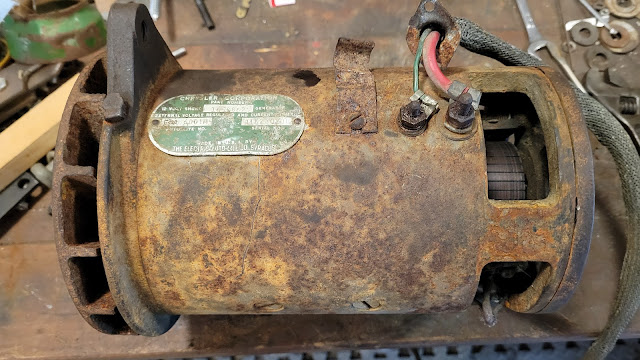So, the blog I did a couple days ago regarding brakes mentioned that brakes are usually a problem on old vehicles that will need serious attention. Another very normal problem is the charging system. This truck has a 12 volt generator and regulator. I think it came from the factory with a 6 volt system but somewhere along the way it was converted. At least it still has a generator. I don't like it when people put in one of them new-fangled alternators in old vehicles, but I digress.
With the charging system inoperative, my usual first step is to check if the regulator is working, so I pulled it off the truck and opened it up. After a few minutes of looking things over, I spotted what looked like a broken wire. It was quite difficult to see, but yes, there it was. A broken wire barely thicker than a human hair. Ok, so maybe it is several times thicker, but it's still whisper thin. The photo below is the repair I did to it. I soldered in a larger solid strand wire to splice between the end of the broken wire and its terminal. The two photos below show the white wire I added. If you look close at the blow-up photo and squint real good, you can kinda maybe see the thin wire soldered onto the end of the bigger wire.
Yes, most people would have just gone out and bought a new regulator, but where's the challenge in that? (sticker shock: I just looked online and the cheapest one on eBay is $135, NAPA is $190-$240)
Once the lugs were removed, it was time to look for a suitable replacement for the broken insulator.
And drilled two holes.
The next step was to turn down the commutator.
It's several days later and it is time to look into the unregulated output from the generator. At fast idle, it was upwards of 18 volts. That's not good. After a lot of testing with an ohm meter, I realized the Field circuit inside the generator was grounded. Grounding the Field wire is how the regulator regulates the voltage, so when the Field is unintentionally grounded somewhere it's not supposed to be, you get full output all the time from the generator. Under normal operation, the regulator's Field solenoid is opening and closing 50 to 200 times a second in order to regulate the voltage to the battery.
You know what that means. The 41 pound generator has to come out again. Ugh. So out it came, which by the way was ten times easier than the first time. I pulled the thing apart almost all the way and double-checked all wiring and connections. All that fiddling must have done something because after carefully putting it back together, no more grounded Field circuit.
Next problem. Now that the generator was working properly, the regulator wasn't. I figured I'd try cleaning the Field circuit relay's set of points in the regulator first, which fortunately happened to be the problem. While there, I cleaned the other two sets of points also. With everything hooked back up, both the generator and regulator are working great.

















No comments:
Post a Comment